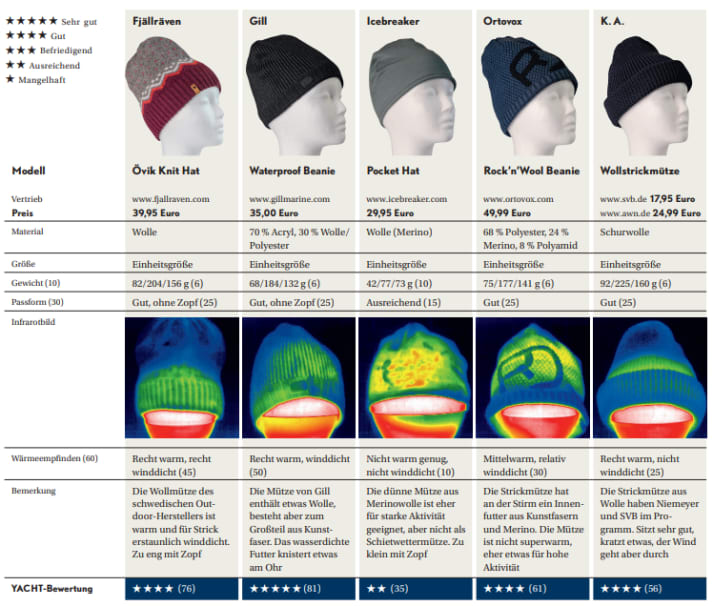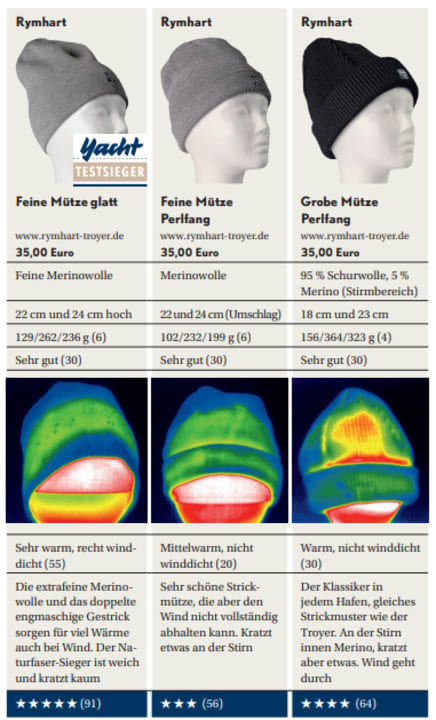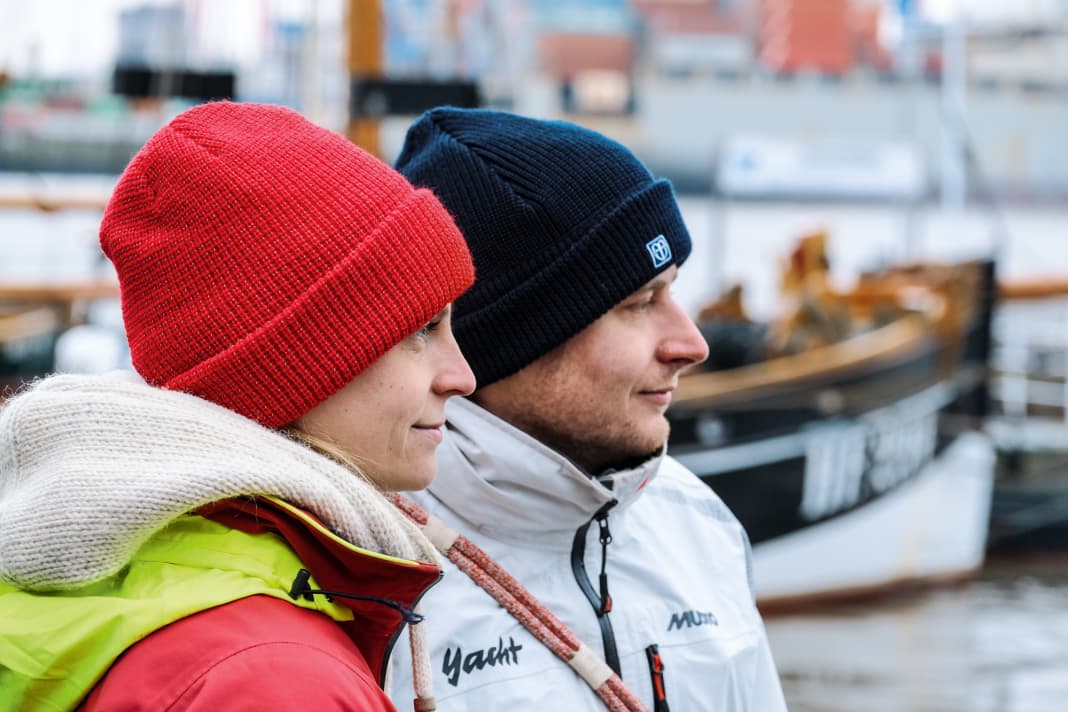





The proverbial cool head should help to master difficult situations, but it should never get cold. Even in the warmer months of the season, this can happen quickly if there is a strong wind or during a night trip. In spring and autumn, on the other hand, warm headgear is unquestionably standard on board. After all, the head has a fairly large surface area of around seven to ten per cent of the entire body and quickly contributes to cooling if unprotected.
As important as this small item of equipment is, it is also underestimated. Everyone has a hat, even non-sailors. But the bobble hat that's good enough for a walk may turn out to be unsuitable on board because the wind blows unhindered through the large meshes against your scalp. We have therefore selected various models for a comparative test and also included products for other sports.
This should be considered when choosing a cap






Synthetic fibres vs. natural fibres: Which hat keeps you warmer?
The test field can also be roughly divided into products made from synthetic and natural fibres. While the majority of the caps are made of acrylic and polyester, the second part of the table contains the test material made of wool. The only exception is the cap from Gill, which is actually mainly made of synthetic fibres, but also has a wool content.
Wool fibres have spectacular properties that even high-tech plastics cannot match. Their surface repels water, but the inside of the fibre can absorb moisture. As a result, wool fabric still feels dry even when it is damp and thus regulates the climate in the garment, a natural breathability.
Wool is also naturally antibacterial and bad odours do not develop so quickly. And if they do, they can simply be removed by airing. Two further plus points that can influence the purchase decision: Wool is a renewable raw material and, unlike synthetic fibres, no microplastics are released into the environment during washing.
However, there are also disadvantages. Not everyone likes the feel of wool on the skin and it can be a little scratchy. In addition, special care must be taken when washing (albeit rarely) to ensure that the fibres do not become matted or even shrink. And wool can pill, i.e. form small knot-like fluffs.
Sven Promer from Rymhart explains it like this: the company's well-known troyer and hats are made from 100 per cent wool out of conviction. Many other manufacturers finish the wool to make it washable and prevent pilling. In many cases, however, this means that the wool thread is coated with a fine polymer net. The natural fibre is coated with plastic and thus also loses some of its positive properties. The (low) plastic content is often not indicated in the material information. If the garment is washable at 40 degrees, it can be assumed that the wool is coated with plastic. In the test field, this suspicion applies to the Icebreaker hat.
The manufacturer of the Ortovox beanie takes a different approach: a thin fleece and merino lining has been sewn into the forehead and ear area to prevent scratching.
Another difference between the materials is the processing of the fibres: Coarse knit patterns trap more air and insulate better. Paradoxically, however, they feel colder in the wind because the wind penetrates through the coarse stitches. In this case, hats with a finer knit, double-layered wool or an additional sewn-in lining are much more suitable.
Waterproof film crackles on the ears
An envelope on the edge of the cap is also an advantage for everyday life on board. This can also be folded down so that the headgear extends even further over the ears. This can be helpful if you have long hair tied back in a plait. The folded-down brim can also be used as a sleeping mask for the eyes.
Some caps, including the models from Sealskinz, Plastimo and Marinepool, have a waterproof film between the outer material and the lining. This can crackle on the ear when you move. This disadvantage must be weighed against the advantage of waterproofness. If the hood of the oilskin is pulled over the cap in the rain, waterproofness is not a decisive factor. However, the headgear can still get wet. Particularly in the case of knitted and woollen models, a ten-hour drying break at room temperature was not enough to remove all moisture. It is therefore advisable to carry a second hat for longer trips in cold weather.
Test in practice and in the laboratory
The test conditions were tough: the air temperature was two degrees Celsius when determining the sensation of warmth. The testers sat on the upper deck of a Hamburg harbour ferry. The speed of the ferry was added to the light but cold easterly wind. It quickly became clear which hat provided good insulation and where cold air was able to get through. In order to substantiate this subjective impression with reproducible data, we took pictures with an infrared camera. Instead of the head, whose temperature can change depending on the previously tested cap, a water-filled balloon was heated to exactly 37 degrees in a special water bath for developing films. When the cap was placed over the balloon, we pressed the shutter release after exactly two minutes.
The pictures confirmed the subjective impression, especially the coarse knit beanie from Rymhart and the model from SVB and Niemeyer showed weaknesses here. The very thin beanies from Icebreaker and the Infinium Beanie from Musto are more suitable for sweat-inducing activities and are not designed to keep you warm in cold weather.
The water absorption and drying properties were determined by weighing. After weighing the new cap, it was placed in water, then wrung out and weighed again. The additional weight corresponds to the amount of water remaining in the fabric. All caps were dried overnight at room temperature for ten hours. After this, most of the models still contained a lot of moisture; only at the end of the day were all the products dry. As the thick, warm hats also absorb a particularly large amount of water, points were deducted for them in this category. However, drying behaviour was not given a high score of 10 out of a total of 100 points.
The fit has a higher weighting in the rating. The maximum score of 30 was awarded if the hat fits comfortably on the head and also covers the ears well.
Sailing caps: Who is the test winner?
Overall, two models scored particularly well: the fleece roll cap from Crazy4Sailing and the Activ Polar from Plastimo, both of which achieved 96 points. The product from Crazy4Sailing is also very attractively priced at 11.90 euros and impressed with its super-soft fleece lining. The MPX Fleece Lined Cap follows close behind. It has ear flaps and scored particularly well in cold winds.
The fine knitted hat from Rymhart was awarded a third test winner title in the natural fibre category. The tight stitches and double weave make it super warm and windproof, while the fine merino wool makes it pleasantly soft. It is also long enough to cover the ears and even the eyes if desired. At Rymhart, the caps are also available in different lengths. Only Musto, Marinepool, Sealskinz and some of the Crazy4Sailing models are available in different sizes; all others are available in one size.
The models range in price from 10 to 50 euros. At 35 euros, the Rymhart caps are rather expensive. Only the products from Ortovox and the MPX Fleece Lined Cap from Musto cost just under 50 euros. Despite this, caps are among the most affordable pieces of equipment.
As the test conditions were really tough, all candidates are suitable with the exception of the very thin Pocket Hat and the Infinium. So taste can also be a deciding factor in the selection. Fashion aspects or colouring did not play a role in the test.
This is how we tested
Fit, insulation, windproofness and drying behaviour are the important points for the test. Fit and warmth are subjective values that we assessed as universally as possible using several testers and infrared technology. For the latter point, a water-filled balloon was used, which was always heated to exactly the same temperature. This ensured reproducibility. The drying behaviour was determined by triple weighing: The new cap, the wet (wrung out) cap and after ten hours of drying.
Caps made from synthetic fibres
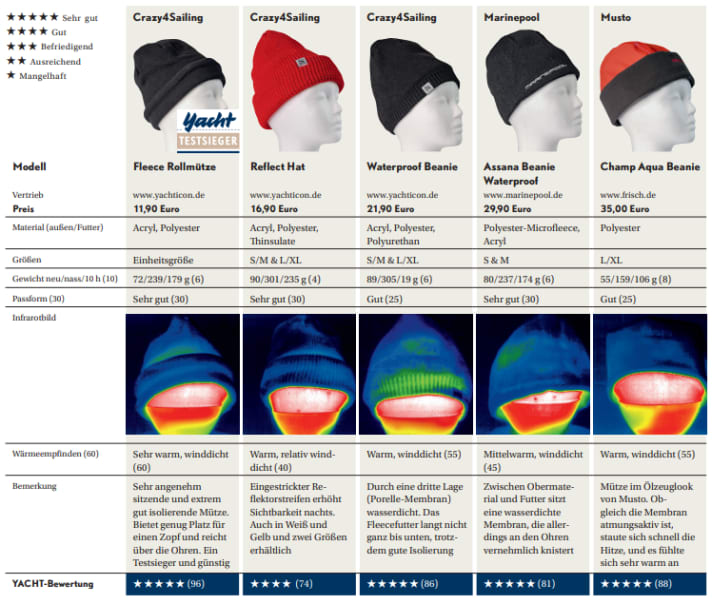
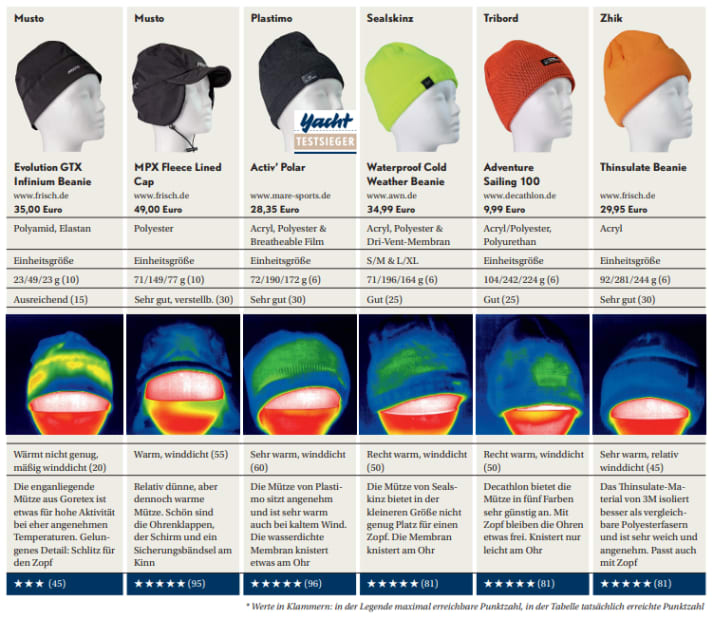
Caps made from natural fibres
